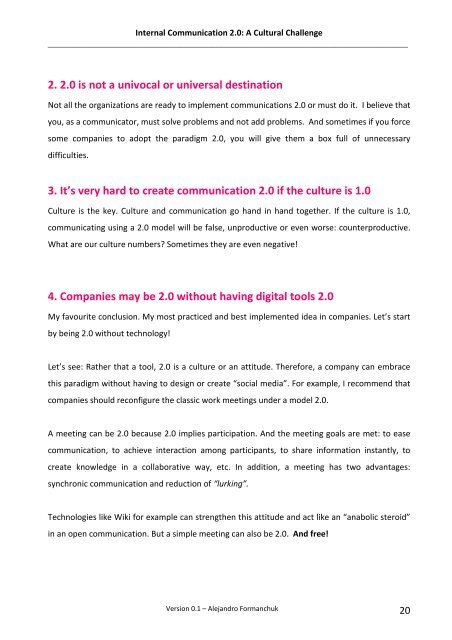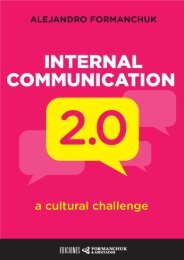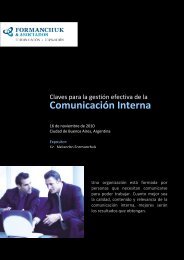Internal Communication 2.0 - Formanchuk & Asociados
Internal Communication 2.0 - Formanchuk & Asociados
Internal Communication 2.0 - Formanchuk & Asociados
Create successful ePaper yourself
Turn your PDF publications into a flip-book with our unique Google optimized e-Paper software.
<strong>Internal</strong> <strong>Communication</strong> <strong>2.0</strong>: A Cultural Challenge<br />
_______________________________________________________________________________<br />
2. <strong>2.0</strong> is not a univocal or universal destination<br />
Not all the organizations are ready to implement communications <strong>2.0</strong> or must do it. I believe that<br />
you, as a communicator, must solve problems and not add problems. And sometimes if you force<br />
some companies to adopt the paradigm <strong>2.0</strong>, you will give them a box full of unnecessary<br />
difficulties.<br />
3. It’s very hard to create communication <strong>2.0</strong> if the culture is 1.0<br />
Culture is the key. Culture and communication go hand in hand together. If the culture is 1.0,<br />
communicating using a <strong>2.0</strong> model will be false, unproductive or even worse: counterproductive.<br />
What are our culture numbers? Sometimes they are even negative!<br />
4. Companies may be <strong>2.0</strong> without having digital tools <strong>2.0</strong><br />
My favourite conclusion. My most practiced and best implemented idea in companies. Let’s start<br />
by being <strong>2.0</strong> without technology!<br />
Let’s see: Rather that a tool, <strong>2.0</strong> is a culture or an attitude. Therefore, a company can embrace<br />
this paradigm without having to design or create “social media”. For example, I recommend that<br />
companies should reconfigure the classic work meetings under a model <strong>2.0</strong>.<br />
A meeting can be <strong>2.0</strong> because <strong>2.0</strong> implies participation. And the meeting goals are met: to ease<br />
communication, to achieve interaction among participants, to share information instantly, to<br />
create knowledge in a collaborative way, etc. In addition, a meeting has two advantages:<br />
synchronic communication and reduction of “lurking”.<br />
Technologies like Wiki for example can strengthen this attitude and act like an “anabolic steroid”<br />
in an open communication. But a simple meeting can also be <strong>2.0</strong>. And free!<br />
Version 0.1 – Alejandro <strong>Formanchuk</strong> 20












